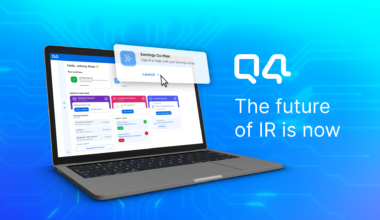This year has been one of tremendous change for the global capital markets, including changes in regulations and structural shifts that have influenced investor sentiment, decision-making, and how companies engage with the investment community. These changes, combined with the new virtual environment, have had a huge impact on IR programs and how IROs engage the sell-side.
In a recent webinar, “Best Practices for Working with the Sell-Side in the New Normal,” Q4’s VP of Strategy, Mike Coffey, connected with members of the sell-side to better understand how their teams are meeting the needs of this new market and helping IROs navigate through these unprecedented times.
This panel of experts, including Mary Turnbull, Managing Director and Head of Corporate Access at Raymond James, Nichole Saland, Managing Director and Head of Corporate Access at Telsey Advisory Group, and Bill Quinn, Head of Client Strategy and Corporate Access at Deutsche Bank, shared valuable insights into how IROs can best work with the sell-side in this new environment and identified new techniques and resources to help navigate and drive success. Here are just a few key takeaways from that discussion.
Best Practices for a New World
Right up front, the panelists pulled from their ongoing conversations with IRO’s and the C-suite to share insights and best practices for engagement and outreach in this new world.
Turnbull pointed to the critical importance of communication in this predominantly virtual world, recommending that IROs share as many details as they can with the sell-side about their objectives and targets, including any specific names they’re hoping to engage. She stressed that fostering that dialogue not only helps her team better understand what her clients want, but also enables her to bring back valuable information and feedback from investors.
While the challenges of the past several months are undeniable, the panelists discussed some of the unexpected advantages of the industry’s pivot to virtual. Saland discussed the increase in access and number of conversations between CFOs and analysts as not only increasing engagement with target investors but introducing a deeper bench of management, including meetings with chief digital officers, chief marketing officers and others. She also suggested that several best practices adopted during this time should be carried into the future, including increased visibility through calls and meetings, keeping presentation overview updated on IR sites, understanding the topics of greatest interest to investors and providing perspective through this increased engagement.
Another way engagement has increased with recent changes can be seen in the significant increase in the volume of requests, meetings, and virtual conference attendees. Quinn noted that investor conference attendance had nearly doubled in recent months while corporate participation has increased 25-30%. He identified a key opportunity in this new environment being the fact that management is much more willing to take meetings when they can do them from home and commended the IROs using this to their advantage, adding: “The virtual world has been very efficient for everyone to be everywhere at all times.”
Continued Adaptation
As this new world continues to drive changes, the panel agreed that savvy IROs will continue to seize the opportunities they present. Coffey points out just one of these opportunities as the ability to do non-deal roadshows without the cost and time commitments formerly required: “Being able to do these non-deal roadshows from your couch and tour most of Europe illustrates that some real efficiencies have come from these developments.”
The rest of the panel expanded on the advantages presented by these virtual NDRs. Saland shared that not much has changed with the cadence of NDRs, but stressed that this tool will remain essential, regardless of the medium used. She reiterated that the regained time from travel provides more options for this crucial type of engagement and represents a very productive use of time for IROs.
Beyond that, she and the other experts suggest that IROs and management think more broadly about these NDRs, given this new environment negates the regional focus once required. “C-levels should think broadly versus regionally, because investors are all over the country,” Saland suggests, adding that IROs should take advantage of this broader reach by filling days with meetings across the country.
Quinn agrees that the formerly regional approach to NDRs is changing in our new reality. While some corporates are still requesting regional NDRs, most have seen the value in a broader approach and have noticed an increase in requests from outside offices to join these virtual meetings – which they may do with or without your invitation. For the most part, this broadening perspective has been very beneficial both in the U.S. and abroad.
“The ability for the U.S. corporate to tap into the European investor has really taken off in this environment,” said Quinn. He added that any legacy resistance to using video or crossing time zones pre-pandemic, has largely broken down. “We’re able to get that European investor involved in U.S. NDRs and conferences, while in the past it wasn’t even an option.”
Turnbull joins her colleagues in recommending that IROs be more flexible to capitalize on the benefits of the virtual NDR and also identifies a new trend that further underscores an increased level of engagement in this new environment. “We’re seeing a lot of reverse inquiries from investors who don’t want to wait until the corporate goes on the virtual road and requests an immediate meeting.”
Looking Out Over the Horizon
The panel discussed a host of other topics and trends impacting IROs and their relationship with the sell-side into the future. Among them were, of course, how the ongoing COVID-19 pandemic will continue to affect engagement and when they expect investor meetings and conferences to be held in person again. They also addressed the impact of potential regulatory changes around 13F filings as well as the evolution of the hedge fund investor relationship. To learn more about all these topics, as well as some very interesting advice for undercovered and underperforming companies on getting the exposure they need, the replay can be found here.


